Related Research Articles

Uzbekistan, officially the Republic of Uzbekistan, is a doubly landlocked country located in Central Asia. It is surrounded by five landlocked countries: Kazakhstan to the north; Kyrgyzstan to the northeast; Tajikistan to the southeast; Afghanistan to the south; and Turkmenistan to the southwest. Its capital and largest city is Tashkent. Uzbekistan is part of the Turkic world, as well as a member of the Organization of Turkic States. Uzbek is the majority-spoken language in Uzbekistan, while Russian is widely spoken and understood throughout the country. Tajik is also spoken as a minority language, predominantly in Samarkand and Bukhara. Islam is the predominant religion in Uzbekistan, most Uzbeks being Sunni Muslims.

Uzbek, formerly known as Turki, is a Turkic language spoken by Uzbeks. It is the official, and national language of Uzbekistan. Uzbek is spoken as either native or second language by 44 million people around the world (L1+L2), making it the second-most widely spoken Turkic language after Turkish. There are two major variants of the Uzbek language, Northern Uzbek spoken in Uzbekistan, Kyrgyzstan, Kazakhstan, Tajikistan, Turkmenistan and China and Southern Uzbek spoken in Afghanistan and Pakistan.

The Tajik Soviet Socialist Republic, also commonly known as Soviet Tajikistan, the Tajik SSR, or simply Tajikistan, was one of the constituent republics of the Soviet Union which existed from 1929 to 1991 located in Central Asia.

The Ustyurt or Ust-Yurt is a transboundary clay desert shared by Turkmenistan, Uzbekistan and Kazakhstan.

The Uzbekistan national football team represents Uzbekistan in international football and is controlled by the Uzbekistan Football Association, the governing body for football in Uzbekistan.
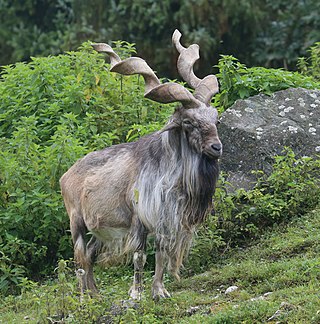
The markhor is a large Capra (goat) species native to Central Asia, mainly within Pakistan, the Karakoram range, and the Himalayas. It is listed on the IUCN Red List as Near Threatened since 2015.
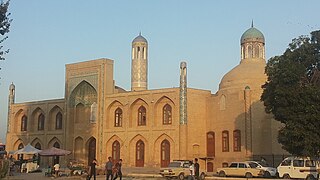
Namangan Region is one of the regions of Uzbekistan, located in the southern part of the Fergana Valley in far eastern part of the country. It is on the right bank of Syr Darya River and borders with Kyrgyzstan, Tajikistan, Tashkent Region, Fergana Region, and Andijan Region. It covers an area of 7,440 km2. The population is estimated to be 2,931,056 (2022), with 35% of the population living in rural areas. The great river Syrdarya, the main waterway in Central Asia, starts in the territory of Namangan. Syrdarya is formed from inflows of the rivers Naryn and Kara Darya. The Namangan region is very rich in various natural resources. In particular, the region extracts oil in Mingbulak District and big gold and diamond deposits have been discovered in Kosonsoy and Pop Districts. There are also large deposits of uranium, silver, aluminum, tungsten, iron, copper, granite, and marble, among others. There are two big mountain tunnels connecting the Fergana valley with the inner city area and other regions of the country, located in the territory of Namangan.
Sarmishsay is located in the Karatau Mountain Range in the Nurata District of Navoiy Region of Uzbekistan. The gorge contains archeological remains dating back as far as the Stone Age, including two petroglyph sites with a total of 10,000 ancient rock carvings. According to UNESCO, it is the largest and most important rock art monument in Uzbekistan.

Uzbek cuisine shares the culinary traditions of peoples across Central Asia. There is a great deal of grain farming in Uzbekistan, so breads and noodles are of importance, and Uzbek cuisine has been characterized as "noodle-rich". Mutton is a popular variety of meat due to the abundance of sheep in the country and it is a part of various Uzbek dishes.

Rubab, Robab or Rabab is a lute-like musical instrument. The rubab, one of the national musical instruments of Afghanistan, is also commonly played in Pakistan and India by Pashtuns, Balochis, Sindhis, Kashmiris and Punjabis. The rubab has three variants, the Kabuli rebab of Afghanistan, the Seni rebab of northern India and the Pamiri rubab of Tajikistan. The instrument and its variants spread throughout West, Central, South and Southeast Asia. The Kabuli rebab from Afghanistan derives its name from the Arabic rebab and is played with a bow while in Central Asia and the Indian subcontinent, the instrument is plucked and is distinctly different in construction.

The karna or karnay is a metal natural trumpet. The name is first mentioned in the biblical book of Daniel, used in the Middle Ages to the Persian military bands and in the Indian Mughal Empire to the representative orchestra naqqāra-khāna and which is still used by this name in ceremonial music in Central Asia and northern India.

The Bukharan markhor, or Tadjik markhor is an endangered goat-antelope, native to Tajikistan, Turkmenistan and Uzbekistan, possibly also Afghanistan. Today it is found in few scattered populations, for example in Kugitang Nature Reserve in easternmost Turkmenistan. The population of the Bukharan markhor is at around 5,750 animals.
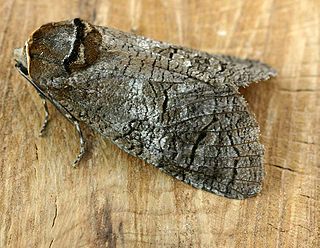
Cossus cossus, the goat moth, is a moth of the family Cossidae. It is found in Northern Africa, Asia and Europe.

The goat or domestic goat is a domesticated species of goat-antelope typically kept as livestock. It was domesticated from the wild goat of Southwest Asia and Eastern Europe. The goat is a member of the animal family Bovidae and the tribe Caprini, meaning it is closely related to the sheep. There are over 300 distinct breeds of goat. It is one of the oldest domesticated species of animal, according to archaeological evidence that its earliest domestication occurred in Iran at 10,000 calibrated calendar years ago.
The Zarautsoy Rock Paintings are a gallery of rock art contains the oldest petroglyphs in Central Asia. The images describe primitive man’s everyday life, and bull and wild goat hunting. The site is located in the Surxondaryo Region of Uzbekistan.

The temir komuz is a Kyrgyz jaw's harp, while the komuz is a three-stringed fretless lute. As an instrument, the temir komuz is unrelated to the komuz in terms of style and structure; however, it takes its name from the other popular Turkic instrument.
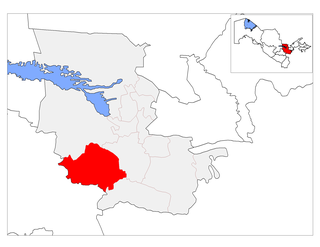
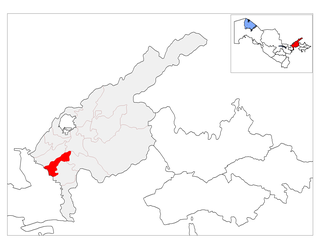
Oqqoʻrgʻon is a district of Tashkent Region in Uzbekistan. The capital lies at the city Oqqoʻrgʻon. It has an area of 400 km2 (150 sq mi) and its population is 130,100.
The Obi-Rakhmat Grotto is a Middle Paleolithic prehistoric site that yielded Neanderthal fossils. It is a shallow karst cave near the junction of the Chatkal and Pskem Rivers at the southwestern end of the Talassky Alatau Range in the Tien Shan Mountains, 100 km (62 mi) northeast of Tashkent, Uzbekistan.
References
- ↑ Oklahoma State University. Uzbek Black Goat. Retrieved on August 23, 2015.